
Waseda University was founded in 1882 (Meiji 15). Its founder, Okuma Shigenobu, was also known as a great diplomat, and it was said that "all roads in the world lead to Waseda," so many people, including foreign dignitaries, visited Okuma's residence in Waseda. This history has been passed down, and throughout its long history, Waseda has invited great people from all over the world. In this article, which commemorates the 142nd anniversary of the university's founding in 2024, we introduce the stories of six guests who have visited the university. We look back on its history, focusing on the Taisho period to the mid-Showa period.
INDEX
▼The genius physicist appears in front of Statue of Shigenobu Okuma
Albert Einstein (1879-1955) (Visited the school in 1922)
▼What message did the “Saint of Triple Suffering” leave behind before leaving Japan?
Helen Keller (1880-1968) <Visited in 1937>
▼ Indian independence hero requests "Northwest of City"
Jawaharlal Nehru (1889-1964) <Visited the school in 1957>
▼Ambassadors to Japan who contributed to building U.S.-Japan relations through diplomacy and research
Edwin O. Reischauer (1910-1990) (Visited the school in 1961)
▼ After a chaotic debate, the bond was forged through a chorus of Alma Mater
Robert F. Kennedy (1925-1968) (visited the school in 1962 and 1964)
▼Many students cheered in response to "The Earth Was Blue"
Yuri Gagarin (1934-1968) <Visited the school in 1962>
Genius physicist appears in front of Statue of Shigenobu Okuma
Albert Einstein (1879-1955) (Visited the school in 1922)
 Albert Einstein, a physicist from Germany, visited Waseda University in 1922 (Taisho 11). Einstein is a giant in the world of physics who published the theory of the light quantum and the theory of relativity. He is also known for his peace movements, such as his opposition to nuclear war after World War II.
Albert Einstein, a physicist from Germany, visited Waseda University in 1922 (Taisho 11). Einstein is a giant in the world of physics who published the theory of the light quantum and the theory of relativity. He is also known for his peace movements, such as his opposition to nuclear war after World War II.
Einstein came to Japan the year after he was awarded the Nobel Prize in Physics in 1921 (Taisho 10). At the time, there was a lot of interest in the theory of relativity in Japan, and he was given an enthusiastic welcome wherever he visited.
He visited Waseda University on November 29th. Many students crowded into the central schoolyard, where Statue of Shigenobu Okuma stands, hoping to catch a glimpse of this rare genius. Einstein pushed his way through the crowd and finally reached the stage in front of the statue. The then president of the university, Masasada Shiozawa, read a welcoming message, to which Einstein expressed his gratitude, saying, "I have observed the unexpected progress being made in the academic world of Japan, and at the same time, I have a strong desire to contribute to the academic world of the world in the future" (*1). The gathered students sang Alma Mater, "Northwest of City," to express their deepest gratitude. This shows the enormous influence of this world-class scientist.
It is said that Einstein listened with interest to President Shiozawa's talk in the VIP room about the university's progress since its founding.

Dr. and Mrs. Einstein are photographed with President Masasada Shiozawa (right), who later became the second President of Waseda University. President Shiozawa welcomed them in fluent German, making use of his experience studying in Germany (Photo: Waseda University Cultural Resources Database)
(※1) From the Waseda Gakuho, Issue 335, published on January 10, 1923
What message did the “Saint of Triple Suffering” leave behind before leaving Japan?
Helen Keller (1880-1968) <Visited in 1937>
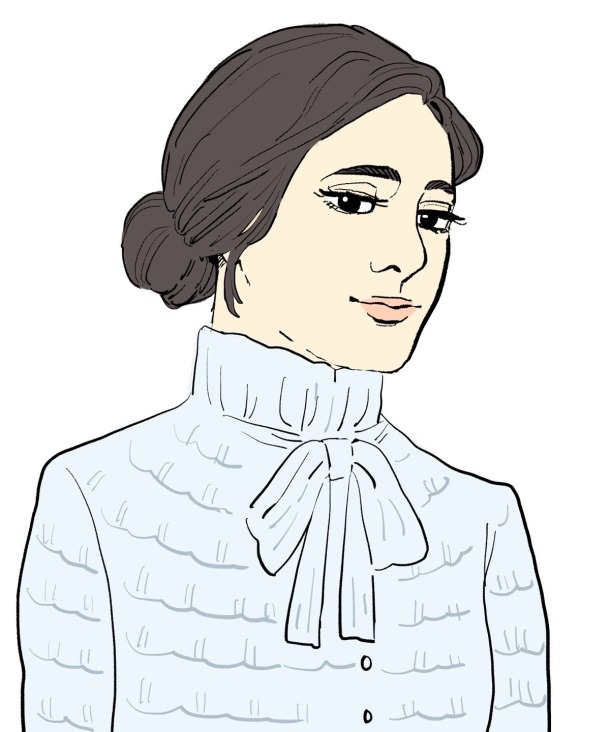
Helen Keller, an American educator and social welfare worker. Keller, who suffered from visual and hearing impairments at a young age, overcame her disabilities through the education of her private tutor Anne Sullivan and her own efforts. After graduating with honors from Radcliffe College, she dedicated herself to training and educating people with disabilities.
Keller, who gave lectures in various countries around the world, visited Waseda University on April 29, 1937 (Showa 12). She took to the stage at Okuma Auditorium to a standing ovation. She gave a lecture titled "The World I Live In," using sign language and translation by her secretary, and forcing her mouth to speak. It is said that the audience went wild when she uttered the words "I am no longer deaf and mute," after talking about her struggle to find light in the dark world of half her life (*2).
Keller's voice, which was reported as a "miracle voice," can only be heard today through limited audio recordings. However, in recent years, a research team from the Waseda University Collaborative Research Center for Theater and Film Studies discovered a recording that is said to be Keller's voice. The recording contains an excerpt from an actual lecture she gave just before leaving Japan. The recording ends with the Japanese words, "Goodbye, thank you."
Unfortunately, there are no photographs remaining from her visit, but it is recorded that on the day, Keller was dressed in simple black clothing, had a gentle smile, and appeared in extremely good health.
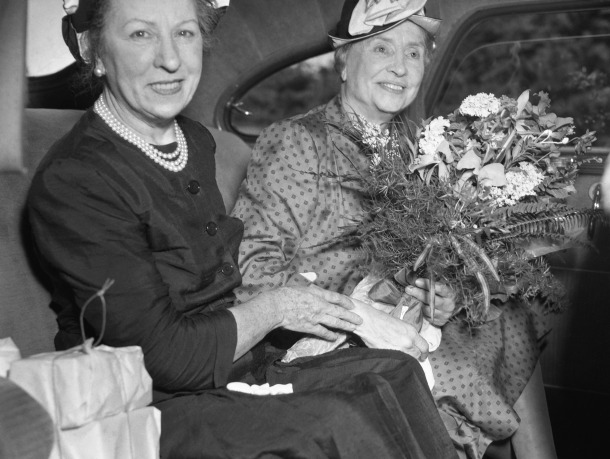
Helen Keller visited Japan three times, in 1937, 1948, and 1955. The photo shows her meeting with the Emperor during her second visit. Helen Keller is on the right. (Photo: Kyodo News)
(※2) Waseda University Newspaper, May 5, 1937
Indian independence hero requests "Northwest of City"
Jawaharlal Nehru (1889-1964) <Visited the school in 1957>
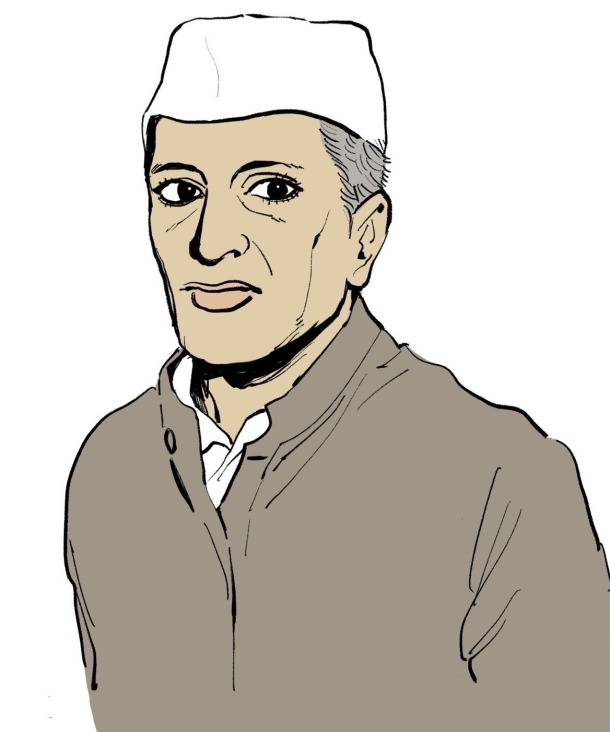
Jawaharlal Nehru, the first Prime Minister of the Republic of India, led the Indian independence movement together with Gandhi. Nehru was a politician who was active internationally, including in concluding the Five Principles of Peace with China and leading the Asian-African Conference. He visited Japan in 1957 (Showa 32).
That year also marked the 75th anniversary of the founding of Waseda University. To commemorate the occasion, the university decided to award Nehru its first honorary doctorate. Thus, on October 7th, Nehru was welcomed at Okuma Auditorium.
About 10,000 students gathered on the day. Naturally, they could not all fit into Okuma Auditorium, and the crowd apparently spilled out into the plaza in front of the auditorium. Inside the auditorium, the then-President of the university, Nobumoto Ohama, presented Nehru with the title of honorary doctorate. It is said that Nehru delivered his speech in "beautiful, rustic" English. The entire audience stood up in applause at his passionate speech. Nehru also requested that everyone sing Alma Mater, "Northwest of City." Even after Nehru had left the auditorium, the chorus continued to echo throughout the plaza (*3).
Nehru's speech, which was scheduled for 10 minutes, was apparently extended by 30 minutes due to the excitement.
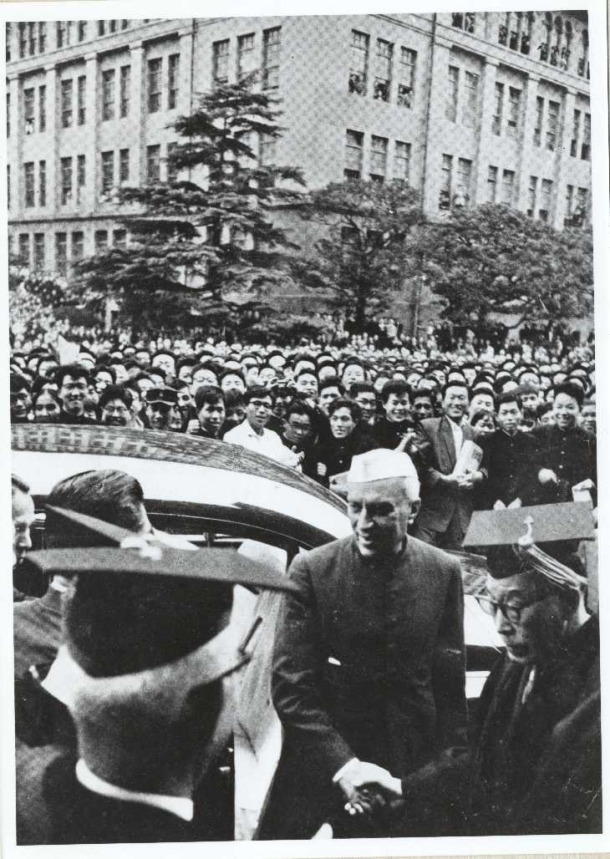
Jawaharlal Nehru (center) with Nobumoto Ohama, the seventh President of Waseda University (far right) in front of the Okuma Memorial Hall (Photo: Waseda University Cultural Resources Database)
(※3) From the Asahi Shimbun, October 8, 1957
Ambassadors to Japan who have contributed to building U.S.-Japan relations through diplomacy and research
Edwin O. Reischauer (1910-1990) (Visited the school in 1961)
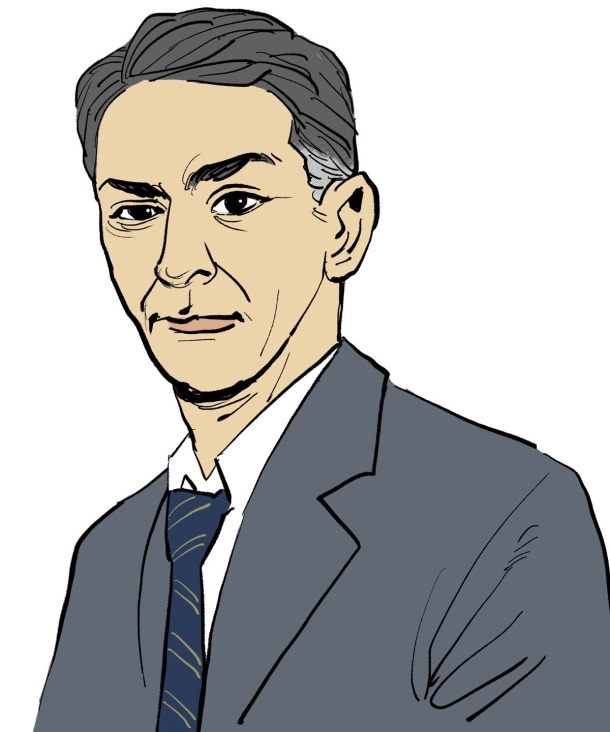 Edwin O. Reischauer was an American scholar and diplomat. Born and raised in Tokyo, Reischauer left Japan at the age of 16, after which he studied Japanese history at Harvard University and was involved in diplomacy with Japan during World War II. After the war, he continued to study Japan at the university, leaving behind great achievements such as working hard to establish the Institute of Japanese Studies. He also served as the U.S. ambassador to Japan from 1961 to 1966, appointed by President John F. Kennedy, and contributed to building U.S.-Japan relations.
Edwin O. Reischauer was an American scholar and diplomat. Born and raised in Tokyo, Reischauer left Japan at the age of 16, after which he studied Japanese history at Harvard University and was involved in diplomacy with Japan during World War II. After the war, he continued to study Japan at the university, leaving behind great achievements such as working hard to establish the Institute of Japanese Studies. He also served as the U.S. ambassador to Japan from 1961 to 1966, appointed by President John F. Kennedy, and contributed to building U.S.-Japan relations.
Reischauer visited our university as the ambassador to Japan on December 14, 1961. During his time as ambassador to Japan, student club activities were thriving at our university, with many new student club being established. Amid this, in 1963, President John F. Kennedy was assassinated. Mourning this tragedy, the American Culture Study Group and others co-hosted a memorial lecture in which Reischauer was invited. Reischauer reported the event to the US, and it is said that Attorney General Robert F. Kennedy was deeply moved (see below). In October of the same year, Reischauer also gave a lecture on the theme of "19th Century Japan" at a lecture commemorating the 125th anniversary of the birth of Shigenobu Okuma.
The Institute of Japanese Studies has since been renamed the Reischauer Institute of Japanese Studies at Harvard University, and Professor Makiko Takeguro (Faculty of Law) has conducted research there as a visiting researcher.

Robert F. Kennedy and his wife (left) with Edwin O. Reischauer and his wife (right) (Photo: Waseda University Cultural Resources Database)
After a chaotic debate, the bond was forged through a chorus of Alma Mater
Robert F. Kennedy (1925-1968) (visited the school in 1962 and 1964)
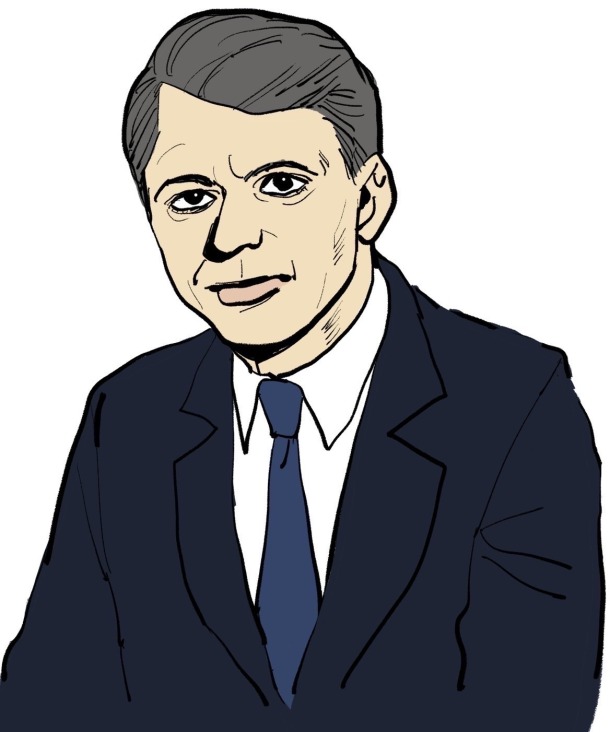
Robert F. Kennedy was the younger brother of US President John F. Kennedy. He served as US Attorney General and worked hard to expand civil rights for blacks and provide relief to the poor. However, in 1968 (Showa 43), the year he announced his candidacy for the presidential election, he was shot and killed at a campaign rally in Los Angeles. He was the second man to be shot and killed, following in the footsteps of his brother, John F. Kennedy.
Robert F. Kennedy's first visit to Waseda University was on February 6, 1962, for a lecture and debate in Okuma Auditorium. However, although he was welcomed with applause by many students that day, the auditorium was thrown into chaos by heckling and shouting from some radical students who were opposed to his visit to Japan.
Kennedy invited the opposing students to come up to the stage and carefully answered their questions. Afterwards, under the direction of a cheerleading club member who stood on the stage, the students sang Alma Mater" Northwest of City," in unison, and the atmosphere on stage became peaceful. The Kennedys reportedly watched the Alma Mater being sung with applause. This incident prompted Kennedy to donate 1.35 million yen, which became the basis for the "Robert Kennedy Scholarship Fund." The fund still functions today as a fund for graduate students.
Kennedy also visited our school again in 1964 to express his gratitude for the aforementioned memorial speech given by President John F. Kennedy. It is said that the students listened quietly to the speech.
Among the audience at this chaotic lecture and debate was Keizo Obuchi (1962 graduate of School of Letters, Arts and Sciences I), a young student who would later become Prime Minister of Japan. The following year, in 1963 (Showa 38), the Waseda Spiritual Uplifting Society crossed the American continent on foot, during which they met Robert F. Kennedy, who praised them for their efforts. In 1968 (Showa 43), two weeks after Robert F. Kennedy was assassinated, the Society held a memorial lecture at Okuma Auditorium.
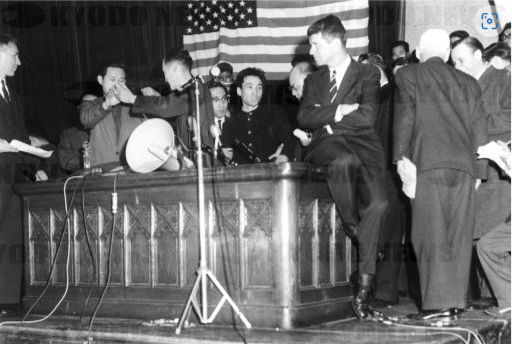
A scene from the lecture and discussion session at the Okuma Memorial Auditorium. Robert F. Kennedy sits on the podium, waiting for the chaos caused by some students to be resolved. (Photo: Kyodo News)
Many students cheered in response to "The Earth Was Blue"
Yuri Gagarin (1934-1968) <Visited the school in 1962>
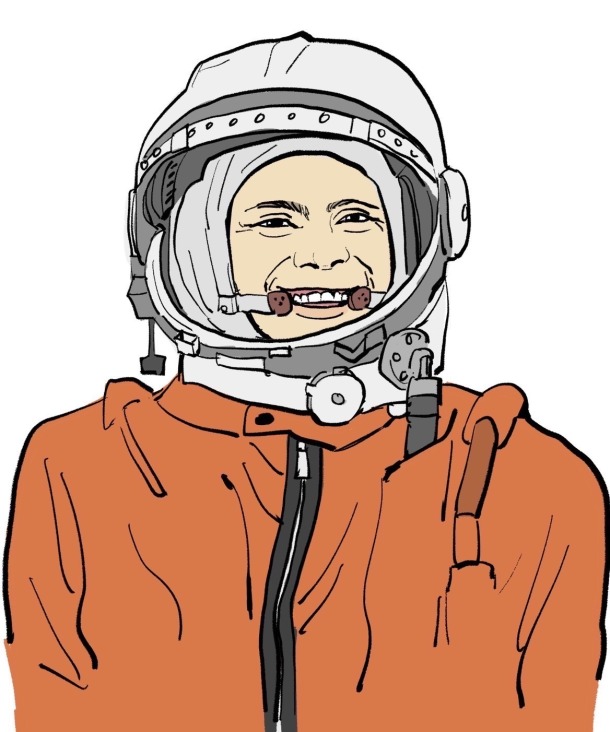
Yuri Gagarin was the first man in space. Gagarin, then of the Soviet Union, boarded the Vostok 1 in 1961 and achieved manned space flight. He left behind the famous quote, "The Earth was blue."
The following year, in 1962, Gagarin visited Memorial Hall (now Waseda Arena) and gave a lecture to about 14,000 students entitled "Prepare for Space Travel!" In it, he explained the history, technology and training of space travel, sharing his own experiences.
Everything, including the weightlessness inside the spacecraft, must have been new to students 60 years ago. The moment the line "The Earth was blue" was uttered, the hall was filled with cheers. Gagarin had such a fondness for Waseda University that the Mainichi Shimbun at the time reported, "What moved the Major the most was the extracurricular lecture he gave at the Waseda Memorial Hall on the afternoon of the 23rd" (*4).
Words recorded in the lecture, such as "Japan was beautiful as seen from the sky during this space trip, but the Japan I see on the ground now is even more beautiful" (*5) and "Currently, there is a proposal from various countries that we should cooperate to make peaceful use of outer space" (*6), are sure to resonate with students living today.
Following Kennedy's visit that same year, the university became wary of student disruption and deployed students from each athletic department to guard Memorial Hall.
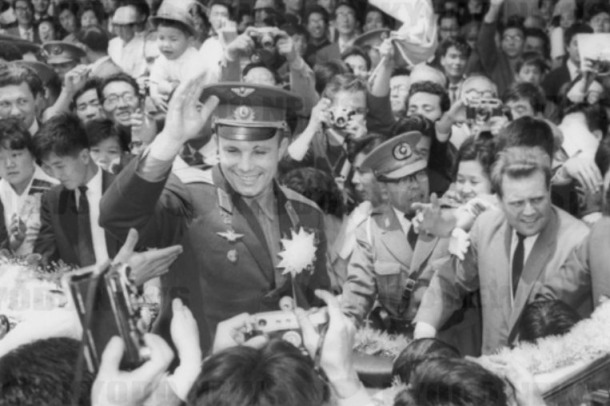
Gagarin waves to the welcoming crowd as he leaves Haneda Airport in an open car during his visit to Japan in 1962 (Photo: Kyodo News)
(※4, ※5) From the Asahi Shimbun, May 24, 1962
(※6) Waseda University Newspaper, May 28, 1962
Many other great people have left their mark on the Waseda University campus. If you are interested, please visit Waseda University History Museum (1st floor, Building No. 1 Waseda Campus).
[References] A Hundred-year History of Waseda University
Interview and text: Yuta Aizawa (2010 Graduate of School of Letters, Arts and Sciences I)
Illustration: Ankoku Miyamiya (Binko Design Office)
[Next Focus Preview] "School Festival Special" to be released on Monday, October 28th

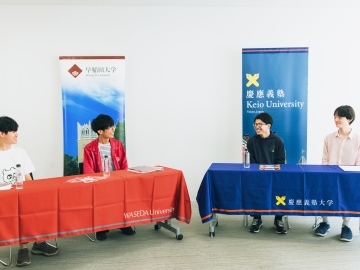
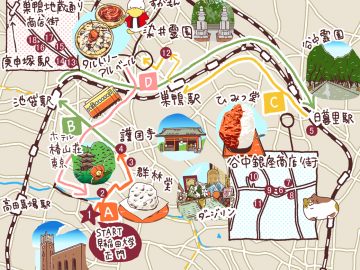
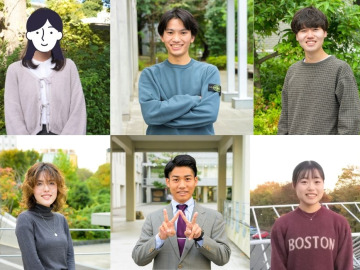
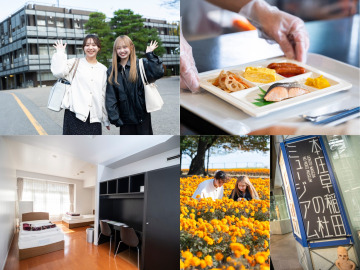
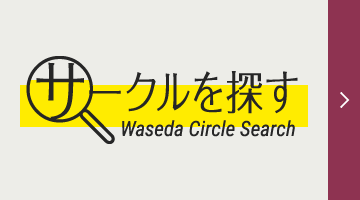
![[Save version] Map of the four main campuses](https://www.waseda.jp/inst/weekly/assets/uploads/2025/09/17cb2975123fc5103172ef60bd98608d-610x458.jpg)

